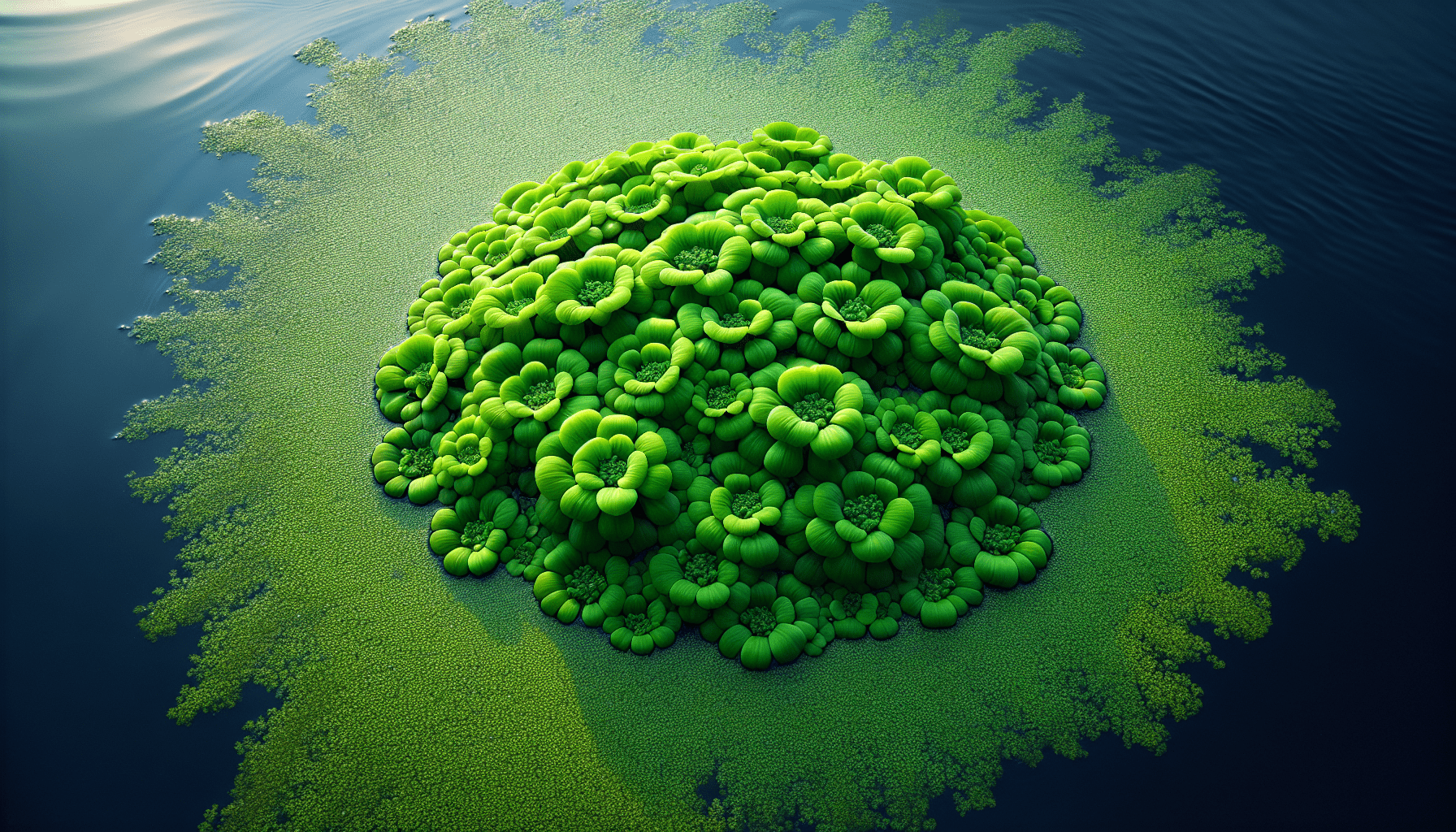In your continued pursuit of understanding the complexities of aquatic ecosystems, the entity known as Spirodela Polyrhiza, commonly referred to as ‘aquatic weed’, stands as a focal point. This article presents an empirical, comprehensive exploration of Spirodela Polyrhiza, focusing on its distinct morphology, habitat, and role played within the pond and lake ecosystems. More so, it provides an in-depth insight into the impact of this particular plant on the overall health and ecology of water bodies it inhabits. With rooted scientific literature and recent research, the illustrative exploration into Spirodela Polyrhiza will enhance your knowledge and appreciation of its unique characteristics.

Understanding Spirodela Polyrhiza
Definition and Description
Spirodela polyrhiza, often referred to as a type of aquatic ‘weed’, is in fact a species of floating aquatic plant. It belongs to the family of duckweeds (Lemnaceae). Despite its simple morphology, it plays a pivotal role in the aquatic ecosystem. It manifests as small, flat green fronds floating atop water bodies. Each frond is essentially a miniature and complete plant body possessing roots, shoots, and reproductive organs.
Habitat and Distribution
You would find Spirodela polyrhiza prevalent across a wide range of habitats, from freshwater ponds, streams, to swamps and marshes. It shows a global distribution, commonly sighted in temperate to tropical regions. You will observe a higher concentration of this species in nutrient-rich, unpolluted water bodies.
Identification Characteristics
The defining feature of Spirodela polyrhiza is its flattened, rounded, green leaf-like structure, called a frond, with several roots hanging below it. Its fronds, usually arranged in colonies, multiply quickly covering the surface of the water body. They are larger and thicker than other duckweeds with a striking glossy appearance.
The Taxonomy of Spirodela Polyrhiza
The Genus Spirodela
Spirodela is a genus within the Lemnaceae family, which includes some of the smallest and simplest flowering plants. The genus name, derived from Greek ‘Speira’ meaning coil and ‘Delos’ meaning clear or visible, denotes the structure of its fruiting body.
Species Distinction
Spirodela polyrhiza is a distinctive species within this genus. The ‘polyrhiza’ in its name, which means ‘many roots’, demarcates it from its close kin, especially Spirodela punctate, by its multiple roots up to 10-20 per frond.
Phylogenetic Relationships
Within the Lemnaceae family, molecular studies suggest that the genus Spirodela is in a group or ‘clade’ with other aquatic species like Lemna and Wolffia. Despite being morphologically minimalistic, its genetic complexity falls in line with higher plants.
Life Cycle of Spirodela Polyrhiza
Growth
The growth cycle of Spirodela polyrhiza is characterized by rapid multiplication under optimized sunlight and nutrient conditions. Each mother frond can produce daughter fronds in a vegetative manner, thereby colonizing the water surface quickly.
Reproduction
Reproduction in Spirodela polyrhiza primarily happens through asexual budding, where daughter fronds bud off from a mother frond. It also possesses the capacity for sexual reproduction through flowering and seed formation, but instances of these occurring are rare.
Life Span
The individual fronds of Spirodela polyrhiza are short-lived, surviving a few weeks in optimal conditions. But the survival of the species is ensured by the continuous production of daughter fronds, making it perennial.

Ecological Role of Spirodela Polyrhiza
Role in Aquatic Ecosystems
Spirodela polyrhiza plays a key role in nutrient cycling in aquatic systems. It absorbs excess nutrients from water, prevents algal blooms, and provides a surface for microbial activities. Additionally, it serves as food for certain fish and birds.
Interactions with other Organisms
Spirodela polyrhiza largely maintains a neutral or positive interaction with other organisms. It provides shelter for water insects, aquatic larvae, and micro-organisms. Certain ducks and fish species consume it as a part of their diet.
Effect on Water Quality
Considered a bio-indicator of water health, Spirodela polyrhiza aids in maintaining the water quality by absorbing pollutants and excess nutrients. However, in certain contexts, if unchecked, its overgrowth might hinder sunlight penetration and oxygen exchange, proving detrimental to the aquatic life beneath.
Nutritional Aspects of Spirodela Polyrhiza
Nutrient Absorption
This species demonstrates efficient nutrient absorption ability, especially nitrogen and phosphorus, directly from the water, using them for its own growth while maintaining the water’s nutrient balance.
Nutritional Value
Spirodela polyrhiza itself is highly nutritious. It boasts of high protein content, essential amino acids, and vitamins, making it valuable in animal feed and potentially as human food.
Potential as a Food Source
Owing to its nutritional content and rapid growth, studies suggest that Spirodela polyrhiza could serve as an alternative, sustainable food source for livestock and also integrate into human food chains.
Adaptive Mechanisms of Spirodela Polyrhiza
Survival Strategies
Spirodela polyrhiza adopts efficient survival strategies like rapid asexual reproduction, clonal growth, and formation of resistant turions for winter survival.
Environmental Tolerance
It shows high tolerance to variations in environmental conditions such as light intensity, temperature, and nutrient levels, furthering its resilient nature.
Threats and Predators
Spirodela polyrhiza faces threats from water pollution and certain fish species and water birds which see it as prey.
Spirodela Polyrhiza as an Invasive Species
Invasion Pathways
Considered invasive in certain areas, Spirodela polyrhiza is often spread through water birds that carry the fronds on their feathers or via water currents.
Impact on Native Species
The rapid growth of Spirodela polyrhiza can lead to monospecific patches, thereby out-competing native species for resources and altering habitat structures.
Management Strategies
Managing it involves physical removal, use of herbicides, or the introduction of natural predators, all requiring careful consideration to maintain ecological balance.
Scientific Research involving Spirodela Polyrhiza
Genome Sequencing
The simplicity of Spirodela polyrhiza provides opportunities for genome sequencing and genetic manipulation studies with far-reaching implications in understanding plant evolution.
Biochemical Studies
Its high protein content and unique metabolic pathways drive research into its biochemical properties and potential use for pharmaceuticals.
Utilization in Research
Apart from genetic and biochemical research, it is used in studies related to wastewater treatment, bioenergy production, and ecological investigations due to its peculiar ecological niche.
Potential Uses of Spirodela Polyrhiza
Biofuel Potential
The rapid growth rate, high starch content, and easy harvest make Spirodela polyrhiza a promising candidate for biofuels and bioenergy production.
Wastewater Treatment
Due to its incredible nutrient absorption capacity, it may serve as a biofilter in wastewater and sewage treatment processes.
Nutritional Applications
With its high nutritional value, Spirodela polyrhiza offers potential applications in livestock feed, aquaculture, and even human nutrition.
Controversies and Concerns around Spirodela Polyrhiza
Environmental Concerns
While it plays a significant ecological role, unchecked growth can lead to water body suffocation and disturbance to local biodiversity.
Invasive Traits
Its invasive traits pose threats to native aquatic ecosystems. In dealing with this, it is necessary to strike a balance between its benefits and potential harms.
Challenges in Management
Managing its growth presents significant challenges, especially determining when its presence is beneficial and when it becomes invasive. This demands careful vigilance and flexible management strategies.